American Bonsai at the NC Arboretum
+95
kingsnake
Tom
MKBonsai
BrianS
manumidam
Chris Cochrane
Intricate Simplicity
chench53
KyleT
Maros Belan
DjTommy
Bolero
Gonetopot
Rick36
M. Frary
Van
Toshiro
fiona
Precarious
drbuzzbee
geo
LanceMac10
MichaelS
kimo
Chellis
Leo Schordje
FrankP999
dick benbow
BrianG
crust
TN Jim
Seth Ellwood
Wander
peterkang
Judgie
Kevin S - Wisco Bonsai
Vance Wood
JMcCoy
brett2013
GerhardGerber
lordy
Eric Group
my nellie
steveb
Jaybird
Todd Ellis
jgeanangel
Daygan
AlainK
Richard S
Randy_Davis
Robert J. Baran
David Brunner
William N. Valavanis
Jkd2572
Dale Cochoy
Jesse McMahon
prestontolbert
yamasuri
bingregory
Stephen Krall
DougB
Ashiod
JADunnagan
sayotefries
JudyB
Dan W.
Khaimraj Seepersad
DuncanJH
Dave Murphy
monte
MikeG
augustine
Russell Coker
Kev Bailey
lennard
BigDave
Marty Weiser
Smithy
coh
tmmason10
dorothy7774
gman
Dave Leppo
hometeamrocker
bwaynef
Billy M. Rhodes
Walter Pall
Sam Ogranaja
JimLewis
MartinSweeney
bonsaisr
Auballagh
John Quinn
Arthur Joura
99 posters
Page 11 of 40
Page 11 of 40 •  1 ... 7 ... 10, 11, 12 ... 25 ... 40
1 ... 7 ... 10, 11, 12 ... 25 ... 40 
 Re: American Bonsai at the NC Arboretum
Re: American Bonsai at the NC Arboretum
My heart is broken for their loss. She was always kind and cheerful to me.
I'm praying for strength for they Doyle family.
Sam
PS - Thank you for sharing that Arthur. Beautiful!!!
I'm praying for strength for they Doyle family.
Sam
PS - Thank you for sharing that Arthur. Beautiful!!!

Sam Ogranaja- Member
 Bless Its Poiny Little Head
Bless Its Poiny Little Head
Sam, thank you for your comment. Mary Kay Doyle was kind and cheerful to everyone!

It is a bit jarring, I think, to see an image like the one above at this time of year, when everything in this part of the world is in the green of summer's lushness. However, just last week (the 21st of June) we in the Northern Hemisphere experienced the summer solstice, so the length of our days is already growing shorter. It really will not be so long until autumn returns!
But my purpose in posting the photo seen above is not to look past the next 3 months towards the season to come, because shortening days or not, we are only now about to enter the overheated heart of the summer season. Rather, I want to tell you about a project undertaken this past winter on the the group planting pictured, a grove of Amur Maples (Acer ginalla).
This group is something I put together 14 or 15 years ago. The primary tree was a landscape specimen that came from the US National Arboretum, propagated, or so I was told, from an Amur Maple that was given to the United States as a gift from Nikita Khrushchev, on behalf of the people of the Soviet Union. The tree was 6' or so tall and potted in a large plastic nursery can. I cut it down and grew it into a bonsai, while also growing out some cuttings, and these together supplied the materials for the planting. The only problem, if a person is inclined to think of it as one, was that the cuttings came from a different Amur Maple. If you look at the photograph you can see that the foliage on the secondary trees is all the same, but that they all are different from the main tree. In my bonsai education I was taught that when a person makes a group or forest planting, the material should all be clonal, so that all the trees will be genetically the same. I can understand the desirability of that, but do not feel that it must be so. In this particular case, it does not bother me, perhaps because it is the primary tree that is different.
While I had no trouble accepting the foliage difference between the number 1 tree and the others in the group, there was another aspect of this planting that was bothersome - all of the trees had over time become rather pointy headed. The initial styling work on this specimen took place during a time when I was keeping very close to the standard bonsai ideal of shaping canopies into asymmetrical triangles, so they were pointed headed to begin with, but there was also a fair amount of apex-creep quietly occurring year after year. Here is a photograph made at the end of 2007:

Here is a view of the group planting this past winter, after leaves had dropped but before I did the overhaul of the top of the canopy:

This is what I ended up with after doing the restyling work:

Bonsai that began their careers being trained to a single line apex present a challenge if you decide later that you want to loosen up that decidedly artificial looking arrangement, and give them a more naturalistic appearance. Otherwise, the standard procedure for lowering the top of bonsai is to cut back to an existing branch that lends itself to being trained upwards, and then use that branch as a continuation of the trunk line running up to the apex. This essentially replaces one single line apex for another. Observation of mature deciduous trees in nature reveals that the vast majority of them do not have a single line apex, just as most of them do not have canopies in the shape of an asymmetrical triangle. The apexes of mature deciduous trees, as well as broad-leafed evergreens, and indeed of a great many coniferous trees, are rounded, and formed by many contributing parts. Instead of a single trunk line from the base of the tree to the apex, generally the trunk line splits into several lines going in various upward directions in the upper third of the tree, and these several lines together form the rounded apex.
Again, taking a bonsai that has been trained to have a single line apex and trying to convert it to a multiple line apex is a challenging undertaking. Sometimes it may mean setting back the developmental track of your tree by several years. In the case of this Amur Maple group, I decided to not be so dogmatic about it. Rather than effect a complete transformation from single to multiple lines, I focused on lowering the tops, rounding out the canopies and generally looking for branches that were situated in a way that presented the opportunity for them to go up at their ends, rather than out, and contribute as part of the crown. As a result, although most of the trees in the group still have a single line trunk from base to apex, the pointy-ness is eliminated and the crown is more relaxed.
If it is difficult to follow the written explanation of it, perhaps a visual comparison will prove more clear. What follows are before and after images of the tops of the trees; the first 2 being of the primary tree, the second 2 showing the secondary tree (located in the center of the 6-tree group) and the last 2 showing the combined apexes of the 2 trees on the furthest right of the composition. Remember, the height of all these trees was reduced by 3" or 4" (76mm or 101mm). See if you can see where the cuts were made:






Here is an image of this same Amur Maple group, as it currently looks out on display in the Bonsai Exhibition Garden:
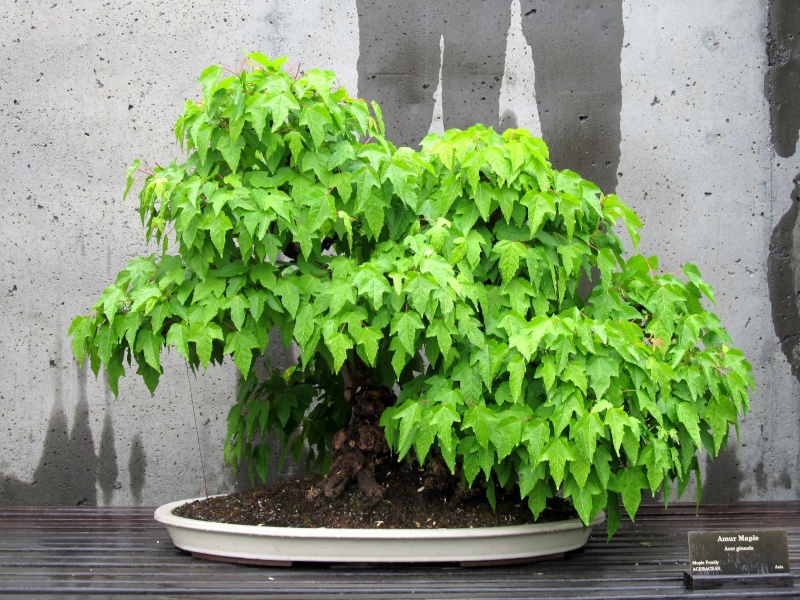

It is a bit jarring, I think, to see an image like the one above at this time of year, when everything in this part of the world is in the green of summer's lushness. However, just last week (the 21st of June) we in the Northern Hemisphere experienced the summer solstice, so the length of our days is already growing shorter. It really will not be so long until autumn returns!
But my purpose in posting the photo seen above is not to look past the next 3 months towards the season to come, because shortening days or not, we are only now about to enter the overheated heart of the summer season. Rather, I want to tell you about a project undertaken this past winter on the the group planting pictured, a grove of Amur Maples (Acer ginalla).
This group is something I put together 14 or 15 years ago. The primary tree was a landscape specimen that came from the US National Arboretum, propagated, or so I was told, from an Amur Maple that was given to the United States as a gift from Nikita Khrushchev, on behalf of the people of the Soviet Union. The tree was 6' or so tall and potted in a large plastic nursery can. I cut it down and grew it into a bonsai, while also growing out some cuttings, and these together supplied the materials for the planting. The only problem, if a person is inclined to think of it as one, was that the cuttings came from a different Amur Maple. If you look at the photograph you can see that the foliage on the secondary trees is all the same, but that they all are different from the main tree. In my bonsai education I was taught that when a person makes a group or forest planting, the material should all be clonal, so that all the trees will be genetically the same. I can understand the desirability of that, but do not feel that it must be so. In this particular case, it does not bother me, perhaps because it is the primary tree that is different.
While I had no trouble accepting the foliage difference between the number 1 tree and the others in the group, there was another aspect of this planting that was bothersome - all of the trees had over time become rather pointy headed. The initial styling work on this specimen took place during a time when I was keeping very close to the standard bonsai ideal of shaping canopies into asymmetrical triangles, so they were pointed headed to begin with, but there was also a fair amount of apex-creep quietly occurring year after year. Here is a photograph made at the end of 2007:

Here is a view of the group planting this past winter, after leaves had dropped but before I did the overhaul of the top of the canopy:

This is what I ended up with after doing the restyling work:

Bonsai that began their careers being trained to a single line apex present a challenge if you decide later that you want to loosen up that decidedly artificial looking arrangement, and give them a more naturalistic appearance. Otherwise, the standard procedure for lowering the top of bonsai is to cut back to an existing branch that lends itself to being trained upwards, and then use that branch as a continuation of the trunk line running up to the apex. This essentially replaces one single line apex for another. Observation of mature deciduous trees in nature reveals that the vast majority of them do not have a single line apex, just as most of them do not have canopies in the shape of an asymmetrical triangle. The apexes of mature deciduous trees, as well as broad-leafed evergreens, and indeed of a great many coniferous trees, are rounded, and formed by many contributing parts. Instead of a single trunk line from the base of the tree to the apex, generally the trunk line splits into several lines going in various upward directions in the upper third of the tree, and these several lines together form the rounded apex.
Again, taking a bonsai that has been trained to have a single line apex and trying to convert it to a multiple line apex is a challenging undertaking. Sometimes it may mean setting back the developmental track of your tree by several years. In the case of this Amur Maple group, I decided to not be so dogmatic about it. Rather than effect a complete transformation from single to multiple lines, I focused on lowering the tops, rounding out the canopies and generally looking for branches that were situated in a way that presented the opportunity for them to go up at their ends, rather than out, and contribute as part of the crown. As a result, although most of the trees in the group still have a single line trunk from base to apex, the pointy-ness is eliminated and the crown is more relaxed.
If it is difficult to follow the written explanation of it, perhaps a visual comparison will prove more clear. What follows are before and after images of the tops of the trees; the first 2 being of the primary tree, the second 2 showing the secondary tree (located in the center of the 6-tree group) and the last 2 showing the combined apexes of the 2 trees on the furthest right of the composition. Remember, the height of all these trees was reduced by 3" or 4" (76mm or 101mm). See if you can see where the cuts were made:






Here is an image of this same Amur Maple group, as it currently looks out on display in the Bonsai Exhibition Garden:

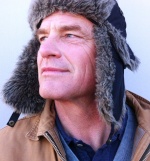
Arthur Joura- Member
 Re: American Bonsai at the NC Arboretum
Re: American Bonsai at the NC Arboretum
Looks great after the re-styling. I love Amurs. This thread is fantastic. Thanks for keeping it going.
Mike
Mike
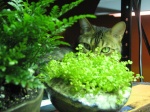
MikeG- Member
 Re: American Bonsai at the NC Arboretum
Re: American Bonsai at the NC Arboretum
Thanks Arthur. Your words are great, but pictures really help. I look forward to October -- when will you provide info on activities/

DougB- Member
 Old Friends Revisit the Mountain
Old Friends Revisit the Mountain
Thank you Mike and Doug, for taking the time to read and respond to my previous post.
Last week I had the pleasure of hosting a visit from my good friends John Geanangel and Ken Duncan, both of the Black Creek Study Group in Columbia, SC. They made the 3-hour drive from where they live to the NC Arboretum in Asheville to spend a day volunteering, and I gladly took advantage of their offer of free expert help. I had a project in mind, too.
Back in 2003, John and Ken joined me onstage at the Carolina Bonsai Expo to do a public demonstration. We made a large tray landscape planting, meant to represent a well known natural area that straddles the border between western North Carolina and eastern Tennessee, named Roan Mountain. We used Shimpaku Junipers (Juniperus chinensis var. sargentii 'Shimpaku') and Zakura Azaleas (Rhododendron kiusianum 'Zakura'). I had grown these plants for about 5 years from cuttings, specifically for this project.
Here are a couple of images from that long ago demonstration:


When I saw these pictures today, after not having looked at them in a long while, I was surprised how young the plant material looked. I was also surprised by how badly Ken and John have aged!
I do not have a picture of the planting as it looked at its completion that day, but I found this image of it from 2005:

Here is what the 'Roan Mountain' planting looked like in 2012, when it was on display at the 3rd US National Bonsai Exhibition:

In preparation for being in the US National show I had gone through all the junipers and azaleas and pruned them in close detail, a job that took about 8 hours. In the 2 years since they had received only maintenance pruning, which meant keeping them tidy and presentable but not doing anything structural. They grew strongly. Here is what the planting looked like earlier last week:

I decided it was time to give the planting another thorough going over, and I knew I could count on my South Carolina friends to make the job easier.
John, Ken and I set ourselves up under the pavilion in the Bonsai Exhibition Garden on a beautiful summer day and went to work:

Being out in the garden meant we were essentially giving a free public demonstration, and throughout the time we were there a more or less steady stream of curious onlookers came by. It is interesting to meet the visitors, who are generally nice, come from all over and have varying amounts of familiarity with bonsai. Naturally, they ask questions. Invariably, a small number of questions get asked over and over - "What kind of plant is that?" "How do you know what to prune?", and of course the ever-popular "How old is that one?" I am used to this because I am regularly working out in the garden and constantly being asked such things. It is part of my job to be patient and friendly and answer the annoyingly repetitious questions without biting off the head of the innocent questioner, which I manage to do most of the time. But I was happy to have Ken and John on hand this day to lend support in this regard too, and I mostly hung back and let them engage with the public. They are both very good in dealing with people, and eagerly interacted with anyone who showed interest. Here is John talking with some visitors from Korea:

In all I think we went at it for about 3 hours or so. I was pleased with the end result:

Here are a couple of detail shots:


For the sake of easy comparison, here, in the order they appear, are the images of the 'Roan Mountain' tray landscape in 2005, last week before pruning, and now:



In bonsai, as in all facets of life, a large measure of our enjoyment comes from the people we meet along the way. I count myself as fortunate to have made friends early on in my bonsai journey with 2 people as talented as John Geanangel and Ken Duncan, and I hope I will have the pleasure of their company for many years to come. They both are members of the IBC, by the way. Both used to post here with some regularity but rarely do any more, although I know they both still check in to read on a frequent basis. So I will take this opportunity to thank them once again for their good help - I appreciate it, guys! Lets do it again sometime soon.
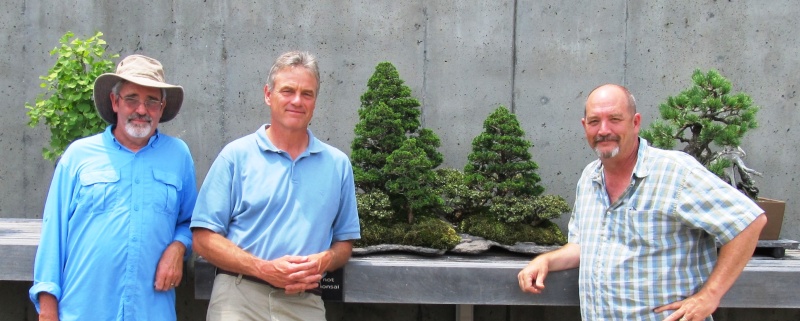
Last week I had the pleasure of hosting a visit from my good friends John Geanangel and Ken Duncan, both of the Black Creek Study Group in Columbia, SC. They made the 3-hour drive from where they live to the NC Arboretum in Asheville to spend a day volunteering, and I gladly took advantage of their offer of free expert help. I had a project in mind, too.
Back in 2003, John and Ken joined me onstage at the Carolina Bonsai Expo to do a public demonstration. We made a large tray landscape planting, meant to represent a well known natural area that straddles the border between western North Carolina and eastern Tennessee, named Roan Mountain. We used Shimpaku Junipers (Juniperus chinensis var. sargentii 'Shimpaku') and Zakura Azaleas (Rhododendron kiusianum 'Zakura'). I had grown these plants for about 5 years from cuttings, specifically for this project.
Here are a couple of images from that long ago demonstration:


When I saw these pictures today, after not having looked at them in a long while, I was surprised how young the plant material looked. I was also surprised by how badly Ken and John have aged!
I do not have a picture of the planting as it looked at its completion that day, but I found this image of it from 2005:

Here is what the 'Roan Mountain' planting looked like in 2012, when it was on display at the 3rd US National Bonsai Exhibition:

In preparation for being in the US National show I had gone through all the junipers and azaleas and pruned them in close detail, a job that took about 8 hours. In the 2 years since they had received only maintenance pruning, which meant keeping them tidy and presentable but not doing anything structural. They grew strongly. Here is what the planting looked like earlier last week:

I decided it was time to give the planting another thorough going over, and I knew I could count on my South Carolina friends to make the job easier.
John, Ken and I set ourselves up under the pavilion in the Bonsai Exhibition Garden on a beautiful summer day and went to work:

Being out in the garden meant we were essentially giving a free public demonstration, and throughout the time we were there a more or less steady stream of curious onlookers came by. It is interesting to meet the visitors, who are generally nice, come from all over and have varying amounts of familiarity with bonsai. Naturally, they ask questions. Invariably, a small number of questions get asked over and over - "What kind of plant is that?" "How do you know what to prune?", and of course the ever-popular "How old is that one?" I am used to this because I am regularly working out in the garden and constantly being asked such things. It is part of my job to be patient and friendly and answer the annoyingly repetitious questions without biting off the head of the innocent questioner, which I manage to do most of the time. But I was happy to have Ken and John on hand this day to lend support in this regard too, and I mostly hung back and let them engage with the public. They are both very good in dealing with people, and eagerly interacted with anyone who showed interest. Here is John talking with some visitors from Korea:

In all I think we went at it for about 3 hours or so. I was pleased with the end result:

Here are a couple of detail shots:


For the sake of easy comparison, here, in the order they appear, are the images of the 'Roan Mountain' tray landscape in 2005, last week before pruning, and now:



In bonsai, as in all facets of life, a large measure of our enjoyment comes from the people we meet along the way. I count myself as fortunate to have made friends early on in my bonsai journey with 2 people as talented as John Geanangel and Ken Duncan, and I hope I will have the pleasure of their company for many years to come. They both are members of the IBC, by the way. Both used to post here with some regularity but rarely do any more, although I know they both still check in to read on a frequent basis. So I will take this opportunity to thank them once again for their good help - I appreciate it, guys! Lets do it again sometime soon.


Arthur Joura- Member
 Re: American Bonsai at the NC Arboretum
Re: American Bonsai at the NC Arboretum
That's a heck of a progression. Thanks for taking the time to post it. I love both the current image, and also the 2005 image. For some reason, the negative space works in that earlier image to my eye almost better than the current image, although the trees are certainly much better and mature now.
JudyB- Member
 Re: American Bonsai at the NC Arboretum
Re: American Bonsai at the NC Arboretum
It was a great day! Of course how could it not be when you combine good friends and something we all love...Mexican food! 
And you thought I was going to say bonsai!
John
And you thought I was going to say bonsai!
John
jgeanangel- Member
 Re: American Bonsai at the NC Arboretum
Re: American Bonsai at the NC Arboretum
One of my favorite tree landscapes! Was the cleanup all pruning and trimming, or did you rewire a bit, too?
Seems to me that a couple of those trees may be getting a bit too large?????? I know bonsai don't last forever, but won't this have to be totally redone at some point?
Seems to me that a couple of those trees may be getting a bit too large?????? I know bonsai don't last forever, but won't this have to be totally redone at some point?

JimLewis- Member
 Re: American Bonsai at the NC Arboretum
Re: American Bonsai at the NC Arboretum
I will be on my way to South Carolina next week to visit some friends in Beauford SC on Lady Island
I am planning to stop by and visit your place and see those beautiful Bonsais in person.
Hope to see more on this trip from Canada.
I am planning to stop by and visit your place and see those beautiful Bonsais in person.
Hope to see more on this trip from Canada.

Judgie- Member
 Re: American Bonsai at the NC Arboretum
Re: American Bonsai at the NC Arboretum
the thing i really dig, besides the obvious vigor of the trees, is the play of light and shadow as the light makes its way through parts of the canopy and down into the understory... truly, a beautiful living snapshot of that part of the world.
really looking forward to my visit later this year.
really looking forward to my visit later this year.

Kevin S - Wisco Bonsai- Member
 Re: American Bonsai at the NC Arboretum
Re: American Bonsai at the NC Arboretum
Thank you for continuing this thread Arthur! I enjoy it immensely! I've been away from IBC for a bit, but I came back mostly to catch up on this thread.
The Trident from the Imperial Palace is one of my favorite maples period. Maybe my favorite Trident in the States! It's much bigger than I expected from previous pictures..
The progression and history of the Mugo was also very enjoyable.
Thanks!
Dan
The Trident from the Imperial Palace is one of my favorite maples period. Maybe my favorite Trident in the States! It's much bigger than I expected from previous pictures..
The progression and history of the Mugo was also very enjoyable.
Thanks!
Dan

Dan W.- Member
 More About the 'Roan Mountain' Planting, and the Longterm Maintenance of Tray Landscapes
More About the 'Roan Mountain' Planting, and the Longterm Maintenance of Tray Landscapes
Thanks to Judy, John, Jim, Judgie, Kevin and Dan for reading and commenting!
Dan, it is good to see you back here. I was thinking of you the other day, as I was looking at the second of our 2 Limber Pines, the one about which I have not yet posted. It is having a good growing season so I expect I will photograph it and post about it in the not too distant future.
Judy, I also like both images of the 'Roan Mountain' planting - the earliest and the most recent. The look of the planting in that picture from '05 actually looks more the way I think of the real Roan Mountain as looking when I picture it in my mind. Here is a photograph I think captures it well:

That image is from 2003, the year Ken, John and I originally put together the bonsai version of Roan Mountain. The 3 of us, in preparation for doing the planting later that year, traveled to Roan Mountain in mid-June to see the Catawba Rhododendron (Rhododendron catawbiense) in bloom. Luckily for us we visited maybe a week too soon to catch the flower show in full glory. I say "luckily" because the day we went, a weekday, we had the place pretty much to ourselves, and that is how I usually want to experience the great outdoors. When the flowers are at their peak, Roan Mountain is heavily trafficked with visitors who come to see the show, even on weekdays. On weekends the park is almost always busy, and when the flowers are out it can get downright crowded. When we went most of the flowers were not yet opened, but some were:



It should be understood that the great masses of rhododendron on Roan Mountain are naturally occurring, and these are old plants. A person can wiggle in under the canopy of some of the larger specimens and stand nearly upright, and if you do, it looks like this:

While the acres of rhododendron provide the flower show, they share the space with many other plant species. Most prominent among these others are 2 high-elevation Southern Appalachian conifers - Red Spruce (Picea rubens) and Fraser Fir (Abies fraseri), whose evergreen spires can be seen poking out of the rhododendron masses or framing them and providing a perfect dark green backdrop:


Although much of the spruce-fir forest in Southern Appalachia has been ravaged by environmental degradation and an introduced pest species, up on Roan Mountain you can still see some old, moss covered soldiers:

The summit of Roan Mountain is over 6,000 feet in elevation, so the climate can be severe. It may be the south and the climate is certainly changing, but there is still abundant snowfall up there:


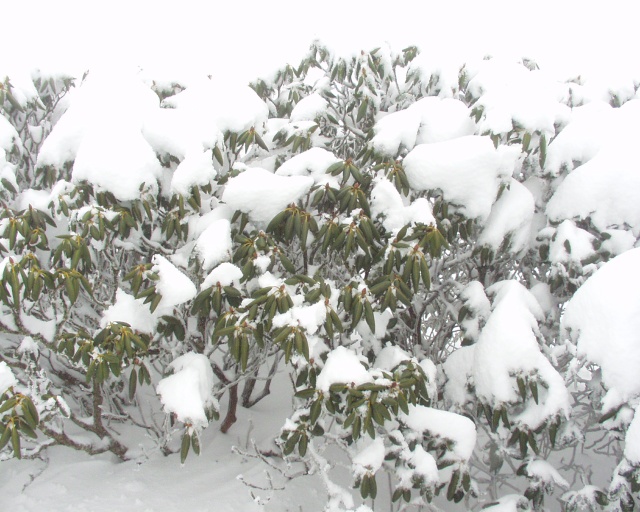
The above photographs were made in the month of April, by the way, on a day when the weather in nearby Asheville was warm and sunny.
Our miniature Roan Mountain is sometimes bedecked in snow, too:

This planting is one of a small handful in our bonsai collection that consists entirely of plant material that can tolerate the extremes of winter, and so it remains on the bench, on display in the Bonsai Exhibition Garden all through the year.
While I am at it, I should post a picture of what the 'Roan Mountain' tray landscape looks like when the Rukizon Azaleas (Rhododendron kiusianum 'Rukizon') are in bloom:

That particular azalea cultivar was chosen because its bloom color closely approximated the colors of Catawba Rhododendron flowers.
Jim, your question about the need to eventually redo the 'Roan Mountain' landscape is legitimate. Just as when you cultivate a bonsai in a pot, plantings on slabs will eventually run out of room to grow and be healthy. However, I think it is still some years away before I may have to deal with that in this particular case. The plants in the landscape have grown significantly larger, but they are still healthy and comfortable where they are. It may be that for visual reasons you feel some of the trees are too big, but that is a matter of personal taste and to me they look good. Judy also voiced appreciation for the appearance of the junipers when they were younger and smaller, and I do not disagree, but for me the power and stately weight of the more mature junipers has greater appeal.
Maintenance of these tray landscapes is an ongoing concern, as it is for single tree bonsai, but I think the process is a little more complex. In a single tree planting you have to manage all the parts of the tree to achieve and maintain balance and harmony. With a tray landscape you have to do that with each of the individual plants that make up the scene, but then all of them together must be managed so as to promote the balance and harmony of the whole.
I recently worked over in a similar fashion another of our tray landscape plantings. The piece in this case was our representation of another well known western North Carolina natural area - Mount Mitchel, highest peak in the US east of the Mississippi River. Our 'Mount Mitchel' planting features 2 dwarf spruce (Picea glauca 'Jean's Dilly'), an unknown dwarf azalea (Rhododendron cv.), and a ground cover of dwarf Creeping Jenny (Lysimachia japonica var. minutissima) and dwarf yarrow (Achillea x lewisii 'King Edward'). Well, the dwarf spruce wants nothing more than to form a dense, impenetrable, conical mass of foliage, while the azalea grows like a weed, and the Creeping Jenny and the yarrow are each bent on world dominance, ceaseless in their sprawling consumption of real estate. Here is what the planting looked like before pruning:

And after:

A case can be made that the 'Mount Mitchel' tray landscape looked better before getting thinned out, but that appealingly full and luxuriant look is not sustainable. If you are not of the opinion that it looked overgrown in the "before" image, a couple of weeks later you would be obliged to change your mind. So, when I think the plants in the scene are getting too plump and comfortable I go through them and trim them out in detail, lest they continue on their merry way and end up destroying the illusion they are meant to create. This is actually the 2nd iteration of this piece. The first, put together in 1996, finally got to the point where it was not possible for me to keep everything under control. After 10 years I took it apart and started over, with other, younger plants. I expect that may need to happen again someday.
By the way, I took 'Mount Mitchel' off display after the pruning session. I had to cut the azalea so drastically that it now needs to be out of sight for a little while, until it can grow back a few leaves:

Dan, it is good to see you back here. I was thinking of you the other day, as I was looking at the second of our 2 Limber Pines, the one about which I have not yet posted. It is having a good growing season so I expect I will photograph it and post about it in the not too distant future.
Judy, I also like both images of the 'Roan Mountain' planting - the earliest and the most recent. The look of the planting in that picture from '05 actually looks more the way I think of the real Roan Mountain as looking when I picture it in my mind. Here is a photograph I think captures it well:

That image is from 2003, the year Ken, John and I originally put together the bonsai version of Roan Mountain. The 3 of us, in preparation for doing the planting later that year, traveled to Roan Mountain in mid-June to see the Catawba Rhododendron (Rhododendron catawbiense) in bloom. Luckily for us we visited maybe a week too soon to catch the flower show in full glory. I say "luckily" because the day we went, a weekday, we had the place pretty much to ourselves, and that is how I usually want to experience the great outdoors. When the flowers are at their peak, Roan Mountain is heavily trafficked with visitors who come to see the show, even on weekdays. On weekends the park is almost always busy, and when the flowers are out it can get downright crowded. When we went most of the flowers were not yet opened, but some were:



It should be understood that the great masses of rhododendron on Roan Mountain are naturally occurring, and these are old plants. A person can wiggle in under the canopy of some of the larger specimens and stand nearly upright, and if you do, it looks like this:

While the acres of rhododendron provide the flower show, they share the space with many other plant species. Most prominent among these others are 2 high-elevation Southern Appalachian conifers - Red Spruce (Picea rubens) and Fraser Fir (Abies fraseri), whose evergreen spires can be seen poking out of the rhododendron masses or framing them and providing a perfect dark green backdrop:


Although much of the spruce-fir forest in Southern Appalachia has been ravaged by environmental degradation and an introduced pest species, up on Roan Mountain you can still see some old, moss covered soldiers:

The summit of Roan Mountain is over 6,000 feet in elevation, so the climate can be severe. It may be the south and the climate is certainly changing, but there is still abundant snowfall up there:



The above photographs were made in the month of April, by the way, on a day when the weather in nearby Asheville was warm and sunny.
Our miniature Roan Mountain is sometimes bedecked in snow, too:

This planting is one of a small handful in our bonsai collection that consists entirely of plant material that can tolerate the extremes of winter, and so it remains on the bench, on display in the Bonsai Exhibition Garden all through the year.
While I am at it, I should post a picture of what the 'Roan Mountain' tray landscape looks like when the Rukizon Azaleas (Rhododendron kiusianum 'Rukizon') are in bloom:

That particular azalea cultivar was chosen because its bloom color closely approximated the colors of Catawba Rhododendron flowers.
Jim, your question about the need to eventually redo the 'Roan Mountain' landscape is legitimate. Just as when you cultivate a bonsai in a pot, plantings on slabs will eventually run out of room to grow and be healthy. However, I think it is still some years away before I may have to deal with that in this particular case. The plants in the landscape have grown significantly larger, but they are still healthy and comfortable where they are. It may be that for visual reasons you feel some of the trees are too big, but that is a matter of personal taste and to me they look good. Judy also voiced appreciation for the appearance of the junipers when they were younger and smaller, and I do not disagree, but for me the power and stately weight of the more mature junipers has greater appeal.
Maintenance of these tray landscapes is an ongoing concern, as it is for single tree bonsai, but I think the process is a little more complex. In a single tree planting you have to manage all the parts of the tree to achieve and maintain balance and harmony. With a tray landscape you have to do that with each of the individual plants that make up the scene, but then all of them together must be managed so as to promote the balance and harmony of the whole.
I recently worked over in a similar fashion another of our tray landscape plantings. The piece in this case was our representation of another well known western North Carolina natural area - Mount Mitchel, highest peak in the US east of the Mississippi River. Our 'Mount Mitchel' planting features 2 dwarf spruce (Picea glauca 'Jean's Dilly'), an unknown dwarf azalea (Rhododendron cv.), and a ground cover of dwarf Creeping Jenny (Lysimachia japonica var. minutissima) and dwarf yarrow (Achillea x lewisii 'King Edward'). Well, the dwarf spruce wants nothing more than to form a dense, impenetrable, conical mass of foliage, while the azalea grows like a weed, and the Creeping Jenny and the yarrow are each bent on world dominance, ceaseless in their sprawling consumption of real estate. Here is what the planting looked like before pruning:

And after:

A case can be made that the 'Mount Mitchel' tray landscape looked better before getting thinned out, but that appealingly full and luxuriant look is not sustainable. If you are not of the opinion that it looked overgrown in the "before" image, a couple of weeks later you would be obliged to change your mind. So, when I think the plants in the scene are getting too plump and comfortable I go through them and trim them out in detail, lest they continue on their merry way and end up destroying the illusion they are meant to create. This is actually the 2nd iteration of this piece. The first, put together in 1996, finally got to the point where it was not possible for me to keep everything under control. After 10 years I took it apart and started over, with other, younger plants. I expect that may need to happen again someday.
By the way, I took 'Mount Mitchel' off display after the pruning session. I had to cut the azalea so drastically that it now needs to be out of sight for a little while, until it can grow back a few leaves:


Arthur Joura- Member
 Re: American Bonsai at the NC Arboretum
Re: American Bonsai at the NC Arboretum
Great workings, Arthur! Look very natural, and full of feelings, especially the one with a deadwood. As a Chinese, I'm very loving your bonsai works, I see simplicity, originality, natural beauty from them, without too many bonsai theories, and learning from nature. Perhaps these are the real bonsai.
Please keep posting!
Thanksss
Kang
Please keep posting!
Thanksss
Kang

peterkang- Member
 Re: American Bonsai at the NC Arboretum
Re: American Bonsai at the NC Arboretum
Well said PeterKang. And Arthur as always thanks for your great pictures and well written narratives. Your pictures are a blessing to those of us who can not get out and about anymore. Thanks.

DougB- Member
 Re: American Bonsai at the NC Arboretum
Re: American Bonsai at the NC Arboretum
peterkang wrote: I see simplicity, originality, natural beauty from them, without too many bonsai theories, and learning from nature. Perhaps these are the real bonsai.
i agree doug !
right-on, kang !!!

Kevin S - Wisco Bonsai- Member
 A Humble Mission
A Humble Mission
Doug and Kevin - I appreciate the 2 of you for being faithful readers of this thread, and for being frequent commentators who always have something positive to offer.
Kang - Thank you for the kind words. I do bonsai in a way that makes sense to me, and allows me to fulfill my desire to communicate to others who share an appreciation of the natural world. Such people can be found everywhere on earth, regardless of their race or creed or the country they call home.
The other day I was working in the Bonsai Exhibition Garden, pruning one of the trees in the garden landscape, and I happened to be nearby a certain bonsai that has been on exhibit for the last few months. This specimen is modest in its size, approximately 16" (406.4mm) in height and width, is not currently flowering or bearing fruit, and has no dramatic deadwood. Yet throughout the time I was there, numerous people took particular interest in this tree, several of them even calling out to others they were with to come have a look. I was surprised. Of course I like the bonsai and think it has some merit, otherwise it would not be on display in the garden, but I never have thought of it as anything particularly special.
Well, they are all special, are they not? Any bonsai in which a person has invested care, and which in turn has responded with health and beauty, has some degree of specialness about it. There are features, however, that will draw more attention to any bonsai that has them. Deadwood - especially extensive, dramatic, stark white deadwood - leaps to mind as an example, although flowers, fruit and brightly colored foliage can all be included in this category. Size, as in very large or tiny sized bonsai, can also function in such a way. The bonsai that was appealing to so many visitors this day featured none of these attributes. The interest directed at this plant seemed entirely to do with its association to food:

This is a Mission Olive (Olea europaea 'Mission'), planted in a Robert Wallace container. It is too pointy headed for my current bonsai tastes, but perhaps that will change, by and by. According to Wikipedia: "The Mission olive is a cultivar of olive native to California, developed by Spanish missions along El Camino Real in the late 1700s." Further reading revealed this: "Since many olive cultivars are self-sterile or nearly so, they are generally planted in pairs with a single primary cultivar and a secondary cultivar selected for its ability to fertilize the primary one." That might explain why I have never seen this tree produce fruit, although I think I have seen it flower. I freely confess to knowing very little about olives; they are not cold hardy enough to overwinter in western NC without the protection of a greenhouse, and this specimen is the only one I have ever grown. Still, I have seen photographs of gnarly, old olive trees:

And I have seen van Gogh paintings of them, as well:

So I have some appreciation for them as trees of character and distinction. I have also seen photographs of olive bonsai that have been made from old collected plants, and some of these are highly admirable. If olives could be grown around here without overwintering concern and I had access to them, I am certain I would be attracted to this species.
As it is, we have this one in our collection entirely by chance. One day in 2005 an older woman came by the Arboretum and asked to speak with me. She carried with her a bushy looking, glossy leaved plant in a production bonsai pot. She explained to me that the plant was a Mission Olive, 50 years old, grown from seed by her husband who had recently passed away. Her husband had started the plant when he and his wife were younger and living in California, and the plant had lived all its life in a container, and had been carried all over the United States as the couple grew older and relocated several times. The man trained his olive to be a bonsai, but in his later years he did not really keep up with it other than to keep it alive, and it lost its bonsai appearance. He still cared about it, though, and his wife did too. That is why she brought it to the Arboretum that day, hoping it might find a home. I accepted it as a donation mostly because I enjoyed the story behind it, but also because it was beginning to show the character of age in its strangely shaped trunk. I wish I had a picture of what it looked like back then, but I do not.
As I said, I have never thought of this tree as anything special, beyond the story that lies behind it and up until now I was the only one who knew that. But the association with olive fruit, and perhaps even more so with olive oil, causes people to take interest in this plant. That, and the trunk is still pretty interesting:

Kang - Thank you for the kind words. I do bonsai in a way that makes sense to me, and allows me to fulfill my desire to communicate to others who share an appreciation of the natural world. Such people can be found everywhere on earth, regardless of their race or creed or the country they call home.
The other day I was working in the Bonsai Exhibition Garden, pruning one of the trees in the garden landscape, and I happened to be nearby a certain bonsai that has been on exhibit for the last few months. This specimen is modest in its size, approximately 16" (406.4mm) in height and width, is not currently flowering or bearing fruit, and has no dramatic deadwood. Yet throughout the time I was there, numerous people took particular interest in this tree, several of them even calling out to others they were with to come have a look. I was surprised. Of course I like the bonsai and think it has some merit, otherwise it would not be on display in the garden, but I never have thought of it as anything particularly special.
Well, they are all special, are they not? Any bonsai in which a person has invested care, and which in turn has responded with health and beauty, has some degree of specialness about it. There are features, however, that will draw more attention to any bonsai that has them. Deadwood - especially extensive, dramatic, stark white deadwood - leaps to mind as an example, although flowers, fruit and brightly colored foliage can all be included in this category. Size, as in very large or tiny sized bonsai, can also function in such a way. The bonsai that was appealing to so many visitors this day featured none of these attributes. The interest directed at this plant seemed entirely to do with its association to food:

This is a Mission Olive (Olea europaea 'Mission'), planted in a Robert Wallace container. It is too pointy headed for my current bonsai tastes, but perhaps that will change, by and by. According to Wikipedia: "The Mission olive is a cultivar of olive native to California, developed by Spanish missions along El Camino Real in the late 1700s." Further reading revealed this: "Since many olive cultivars are self-sterile or nearly so, they are generally planted in pairs with a single primary cultivar and a secondary cultivar selected for its ability to fertilize the primary one." That might explain why I have never seen this tree produce fruit, although I think I have seen it flower. I freely confess to knowing very little about olives; they are not cold hardy enough to overwinter in western NC without the protection of a greenhouse, and this specimen is the only one I have ever grown. Still, I have seen photographs of gnarly, old olive trees:

And I have seen van Gogh paintings of them, as well:

So I have some appreciation for them as trees of character and distinction. I have also seen photographs of olive bonsai that have been made from old collected plants, and some of these are highly admirable. If olives could be grown around here without overwintering concern and I had access to them, I am certain I would be attracted to this species.
As it is, we have this one in our collection entirely by chance. One day in 2005 an older woman came by the Arboretum and asked to speak with me. She carried with her a bushy looking, glossy leaved plant in a production bonsai pot. She explained to me that the plant was a Mission Olive, 50 years old, grown from seed by her husband who had recently passed away. Her husband had started the plant when he and his wife were younger and living in California, and the plant had lived all its life in a container, and had been carried all over the United States as the couple grew older and relocated several times. The man trained his olive to be a bonsai, but in his later years he did not really keep up with it other than to keep it alive, and it lost its bonsai appearance. He still cared about it, though, and his wife did too. That is why she brought it to the Arboretum that day, hoping it might find a home. I accepted it as a donation mostly because I enjoyed the story behind it, but also because it was beginning to show the character of age in its strangely shaped trunk. I wish I had a picture of what it looked like back then, but I do not.
As I said, I have never thought of this tree as anything special, beyond the story that lies behind it and up until now I was the only one who knew that. But the association with olive fruit, and perhaps even more so with olive oil, causes people to take interest in this plant. That, and the trunk is still pretty interesting:


Arthur Joura- Member
 Backstory
Backstory
That's a beautiful backstory for a tree. I'm so glad you've been able to take a tree that meant a lot to them, and make it something for other people to enjoy. I know many people, myself included, worry about what will happen to their trees after they're gone. I think that the fact that you've gone so far as to put it on display says wonderful things about you. I agree that it is too pointy. Perhaps you can round out the apex over the next few years. In doing so you may be able to thicken the mid trunk some. To my eye it is too thin at the point where it joins the large base.
Wander- Member
 Re: American Bonsai at the NC Arboretum
Re: American Bonsai at the NC Arboretum
A great little tree and better yet, the story. Hopefully we all will obtain, remember and pass on the story behind the trees we obtain from our bonsai brothers and sisters who have departed this earth. Thanks again Arthur.

DougB- Member
 Re: American Bonsai at the NC Arboretum
Re: American Bonsai at the NC Arboretum
IMHO, the better the story, the more special the tree...
regardless of its appearance, it meant something to it's owner and for that to be carried forward by subsequent owners makes it even more endearing.
cheers a.j.
regardless of its appearance, it meant something to it's owner and for that to be carried forward by subsequent owners makes it even more endearing.
cheers a.j.

Kevin S - Wisco Bonsai- Member
 Re: American Bonsai at the NC Arboretum
Re: American Bonsai at the NC Arboretum
If you take a look at the photo with the top third of the apex on the main trunk covered......it wouldn't take much to make the proportions on this tree appear much more spreading and appealing.
Lovely story, I'm glad you took the orphan into your home.
Lovely story, I'm glad you took the orphan into your home.
JudyB- Member
 Trees in Central Park
Trees in Central Park
Thanks to Wander, Doug, Kevin and Judy for each of your responses.
I think every good bonsai has 2 stories - the first being the actual history of the plant (where it came from, who worked on it, how it came to look the way it does, etc.) and the other being the story it tells (battered old survivor, growing on the mountain peak, "the lonesome pine", etc.) Right now, the Mission Olive I showed in the last post has a far better actual history than it does a suggested story. The tree as it is has surface appeal but not much character, beyond that stubby and rugged lower trunk. I will have to work on that.
As Wander pointed out, the transition from the stout base of the trunk to the thinner middle section is not so wonderful, but I do not think I will live long enough to see that change much, and I do not plan on dying anytime soon. I would have to move the plant into an oversize container and let it grow vigorously for many years to fatten up that undersized section, and then cut it back hard and grow a completely new top, which would take however many years more. In my view, it would not be worth the trouble to do that. I can live with the size differential as it is and I think as the tree ages and the newer parts attain the more textured bark that comes with age it will all work out. Judy, I did as you suggested and looked at the image of the Mission Olive with the top third blocked out, and I agree that looks about right. It is certainly a doable thing, but I expect even that more modest alteration will still take a couple of years to effect. Cutting off the present apex is easy enough, but training remaining parts into new positions and filling in the inevitable gaps takes time, even with a plant that gets to grow pretty much all through the year. I expect I will do it, though, and that will help with this bonsai's current character deficiency.
*****************************************************************************************************************************************************************
Last week I was out of the office and away on a family trip. I spent a day in Manhattan with my 2 sons and of course the visit included a long walk in Central Park. For those who do not know, Central Park sits right smack in the middle of the magnificent jumble of steel and glass, concrete and asphalt that covers Manhattan island, which itself is the heart of the most populous city in the United States - New York. The park covers 843 acres and was built in the mid to late 19th century. Designed in part by Frederick Law Olmsted, the father of American landscape architecture, it is the most visited park in the US and stands as a model of visionary urban planning. For all the millions of people who live and work in New York City, spending their days stuffed in little boxes which are themselves stacked atop each other within gigantic boxes, fighting their way through the crowded streets or hurtling along in mechanical worms that race through grimy tunnels under the ground, Central Park is an oasis of leafy green, boulder and wood that offers a chance to step out of the rush and tumult, to feel the earth underfoot, hear the birds sing and look up to the open face of the sky. It is an opportunity for the most city-ish of city people to experience the balm of nature.
It is also an outstanding place to see an impressive variety of great old trees. That is always at the top of my list of things to do when I am there, and this time was no exception. But I was with my sons, and although they indulge my interest in megaflora they do not fully share it, so I was not at liberty to go about it as I would if I was on my own. Still, I managed to take a few pictures, and these I share with you now.
This first image is, I think, a Honey Locust (Gleditsia triacanthos):

I have to guess at this tree's identity because I did not see a label on it, and there are so many different species of plants used in Central Park that it could easily be something else. In fact, looking at the photo now I do not see the prominent thorns that bristle out all over the trunk and limbs of most honey locusts, so it may well be some other related or similar species. My interest in this tree was for the look of it, though, and not particularly for its species. The abruptly angular nature of this specimen makes, in my view, a great model for shaping deciduous bonsai, yet I have seen few deciduous bonsai that have it.
In another case of uncertain identity, this next tree I take to be an American Sycamore (Platanus occidentalis), but it could be some other Platanus species or hybrid:

The children playing beneath it give you some sense of the size of this tree. I like its shape, particularly the length to which the branches extend. It is clearly outside the standard trunk to branch ratio employed in bonsai design. Would you find a bonsai shaped similarly to this tree to be acceptable?
This is a Kwansan Cherry (Prunus serrulata 'Kwansan'), and I am confident of that because it was labeled:

In addition to the interesting shape of the tree in the foreground, I enjoy the relationship between it and the twin-trunk tree in the background. Again, such an arrangement would be possible in bonsai form, but I wonder how it would be received.
This is an American Elm (Ulmus americana):
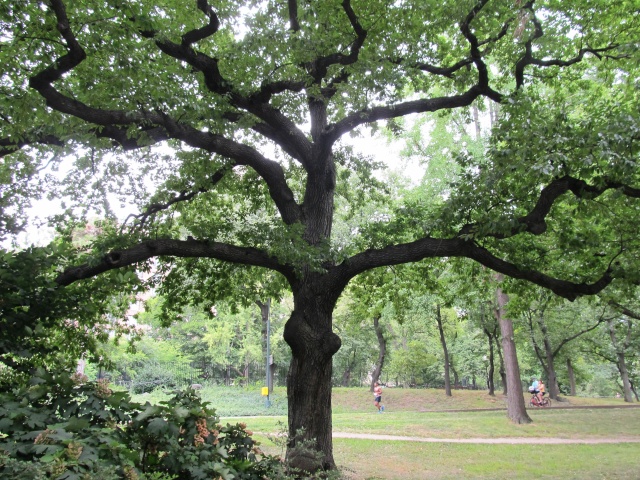
When I saw this tree I immediately thought of a work by my old painter-hero, Paul Cezanne:
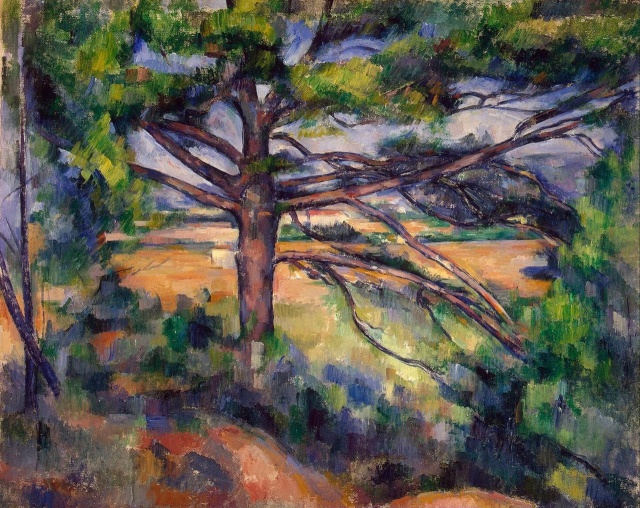
Not likely Cezanne's tree was an American elm, but the shape is remarkably similar. My guess is that this is a not uncommon form for a deciduous tree to assume, but have you ever seen a bonsai shaped this way? Heaven forbid - it has both knobby scars and bar branches! Yet one of the greatest artists in history thought such a tree to be a worthy subject (although Cezanne's tree trades the knobby scars for the perhaps even more offensive sin of reverse taper.)
Speaking of American elms, there are many of them in Central Park:
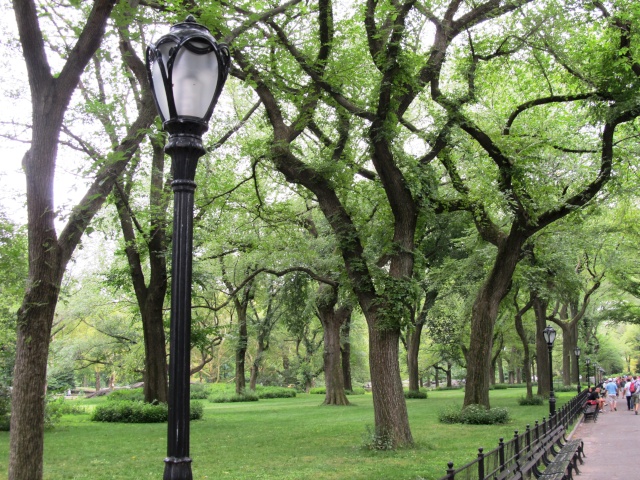
As it happens, the forms exhibited by these trees remind me of another Cezanne painting:
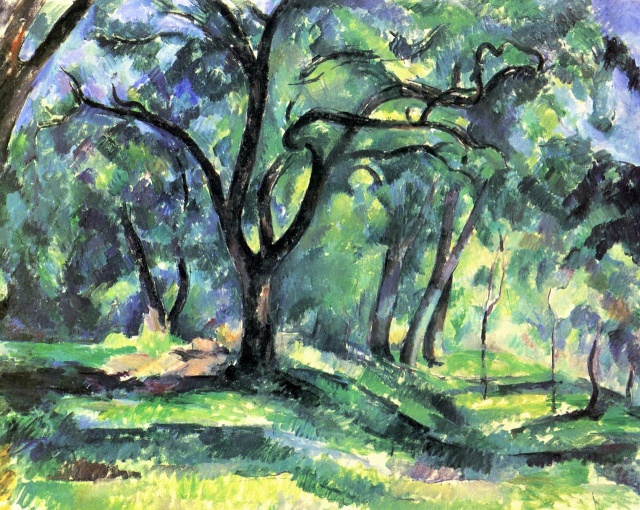
In both the photograph and the painting, take note of the long and sinuous, and in some random cases contorted, shape of the branches. That trees both deciduous and coniferous often assume such shapes is an observable fact all over the world, and was in Cezanne's time as well. Yet once again it is a look seldom found in bonsai design. Such a look is achievable in bonsai, so the dearth of specimens featuring it must be attributable to some other reason.
The preceding image of the American elms shows a small section off to the side of the famous Central Park Mall. This is a mall in the old sense of the word, and not a place to go shopping. A long, wide promenade, this is a pastoral place where people stroll, or skate, or ride bicycles, or simply sit and watch the people parade go by under the arching limbs of great elm trees. I would not call it an allée because the elms do not simply line the walkway, but rather the walkway goes through the middle of an entire grove of American elm trees. I do not think many of the people who seek refuge at the Central Park Mall necessarily know or care that the trees are American elms. They enjoy them for their their shade in the summer and their stately grace all through the year, and they come there for the feeling of the place. The feeling is perceived by the humans, but largely provided by the trees:

No visit to Central Park is complete for me without stopping in at the Metropolitan Museum of Art, which is situated within the park on its eastern boundary. There was a special exhibit at the museum featuring artwork from the Edo Period in Japan, and I went through it because, despite what some people may think, my preference for Western art does not preclude an appreciation for other kinds. I will leave you with this image from that exhibit:

A small detail from a large, six-panel folding screen painted by Kano Sansetsu in the mid-17th century. (www.metmuseum.org)
I think every good bonsai has 2 stories - the first being the actual history of the plant (where it came from, who worked on it, how it came to look the way it does, etc.) and the other being the story it tells (battered old survivor, growing on the mountain peak, "the lonesome pine", etc.) Right now, the Mission Olive I showed in the last post has a far better actual history than it does a suggested story. The tree as it is has surface appeal but not much character, beyond that stubby and rugged lower trunk. I will have to work on that.
As Wander pointed out, the transition from the stout base of the trunk to the thinner middle section is not so wonderful, but I do not think I will live long enough to see that change much, and I do not plan on dying anytime soon. I would have to move the plant into an oversize container and let it grow vigorously for many years to fatten up that undersized section, and then cut it back hard and grow a completely new top, which would take however many years more. In my view, it would not be worth the trouble to do that. I can live with the size differential as it is and I think as the tree ages and the newer parts attain the more textured bark that comes with age it will all work out. Judy, I did as you suggested and looked at the image of the Mission Olive with the top third blocked out, and I agree that looks about right. It is certainly a doable thing, but I expect even that more modest alteration will still take a couple of years to effect. Cutting off the present apex is easy enough, but training remaining parts into new positions and filling in the inevitable gaps takes time, even with a plant that gets to grow pretty much all through the year. I expect I will do it, though, and that will help with this bonsai's current character deficiency.
*****************************************************************************************************************************************************************
Last week I was out of the office and away on a family trip. I spent a day in Manhattan with my 2 sons and of course the visit included a long walk in Central Park. For those who do not know, Central Park sits right smack in the middle of the magnificent jumble of steel and glass, concrete and asphalt that covers Manhattan island, which itself is the heart of the most populous city in the United States - New York. The park covers 843 acres and was built in the mid to late 19th century. Designed in part by Frederick Law Olmsted, the father of American landscape architecture, it is the most visited park in the US and stands as a model of visionary urban planning. For all the millions of people who live and work in New York City, spending their days stuffed in little boxes which are themselves stacked atop each other within gigantic boxes, fighting their way through the crowded streets or hurtling along in mechanical worms that race through grimy tunnels under the ground, Central Park is an oasis of leafy green, boulder and wood that offers a chance to step out of the rush and tumult, to feel the earth underfoot, hear the birds sing and look up to the open face of the sky. It is an opportunity for the most city-ish of city people to experience the balm of nature.
It is also an outstanding place to see an impressive variety of great old trees. That is always at the top of my list of things to do when I am there, and this time was no exception. But I was with my sons, and although they indulge my interest in megaflora they do not fully share it, so I was not at liberty to go about it as I would if I was on my own. Still, I managed to take a few pictures, and these I share with you now.
This first image is, I think, a Honey Locust (Gleditsia triacanthos):

I have to guess at this tree's identity because I did not see a label on it, and there are so many different species of plants used in Central Park that it could easily be something else. In fact, looking at the photo now I do not see the prominent thorns that bristle out all over the trunk and limbs of most honey locusts, so it may well be some other related or similar species. My interest in this tree was for the look of it, though, and not particularly for its species. The abruptly angular nature of this specimen makes, in my view, a great model for shaping deciduous bonsai, yet I have seen few deciduous bonsai that have it.
In another case of uncertain identity, this next tree I take to be an American Sycamore (Platanus occidentalis), but it could be some other Platanus species or hybrid:

The children playing beneath it give you some sense of the size of this tree. I like its shape, particularly the length to which the branches extend. It is clearly outside the standard trunk to branch ratio employed in bonsai design. Would you find a bonsai shaped similarly to this tree to be acceptable?
This is a Kwansan Cherry (Prunus serrulata 'Kwansan'), and I am confident of that because it was labeled:

In addition to the interesting shape of the tree in the foreground, I enjoy the relationship between it and the twin-trunk tree in the background. Again, such an arrangement would be possible in bonsai form, but I wonder how it would be received.
This is an American Elm (Ulmus americana):

When I saw this tree I immediately thought of a work by my old painter-hero, Paul Cezanne:

Not likely Cezanne's tree was an American elm, but the shape is remarkably similar. My guess is that this is a not uncommon form for a deciduous tree to assume, but have you ever seen a bonsai shaped this way? Heaven forbid - it has both knobby scars and bar branches! Yet one of the greatest artists in history thought such a tree to be a worthy subject (although Cezanne's tree trades the knobby scars for the perhaps even more offensive sin of reverse taper.)
Speaking of American elms, there are many of them in Central Park:

As it happens, the forms exhibited by these trees remind me of another Cezanne painting:

In both the photograph and the painting, take note of the long and sinuous, and in some random cases contorted, shape of the branches. That trees both deciduous and coniferous often assume such shapes is an observable fact all over the world, and was in Cezanne's time as well. Yet once again it is a look seldom found in bonsai design. Such a look is achievable in bonsai, so the dearth of specimens featuring it must be attributable to some other reason.
The preceding image of the American elms shows a small section off to the side of the famous Central Park Mall. This is a mall in the old sense of the word, and not a place to go shopping. A long, wide promenade, this is a pastoral place where people stroll, or skate, or ride bicycles, or simply sit and watch the people parade go by under the arching limbs of great elm trees. I would not call it an allée because the elms do not simply line the walkway, but rather the walkway goes through the middle of an entire grove of American elm trees. I do not think many of the people who seek refuge at the Central Park Mall necessarily know or care that the trees are American elms. They enjoy them for their their shade in the summer and their stately grace all through the year, and they come there for the feeling of the place. The feeling is perceived by the humans, but largely provided by the trees:

No visit to Central Park is complete for me without stopping in at the Metropolitan Museum of Art, which is situated within the park on its eastern boundary. There was a special exhibit at the museum featuring artwork from the Edo Period in Japan, and I went through it because, despite what some people may think, my preference for Western art does not preclude an appreciation for other kinds. I will leave you with this image from that exhibit:

A small detail from a large, six-panel folding screen painted by Kano Sansetsu in the mid-17th century. (www.metmuseum.org)

Arthur Joura- Member
 Re: American Bonsai at the NC Arboretum
Re: American Bonsai at the NC Arboretum
NYC 1979... where would i go ?
CBGBs to catch the dead boys, 'natch !
(though i was lucky enough to see them in milwaukee in 1979,
and on a 6 inch stage, 2 feet from stiv, no less !)
2014 ?
central park without a doubt...
i have "skirted" NYC many years ago, but had no desire to pull into town...
now-a-days, i wish i could fly in for 1 day just to experience the oasis in the middle of that sea of humanity and chaos...
and i think the taxi-cab ride from the airport to the park and back to the airport (with no other stops),
would serve as the perfect contrast between the 2 worlds.
CBGBs to catch the dead boys, 'natch !
(though i was lucky enough to see them in milwaukee in 1979,
and on a 6 inch stage, 2 feet from stiv, no less !)
2014 ?
central park without a doubt...
i have "skirted" NYC many years ago, but had no desire to pull into town...
now-a-days, i wish i could fly in for 1 day just to experience the oasis in the middle of that sea of humanity and chaos...
and i think the taxi-cab ride from the airport to the park and back to the airport (with no other stops),
would serve as the perfect contrast between the 2 worlds.

Kevin S - Wisco Bonsai- Member
 Re: American Bonsai at the NC Arboretum
Re: American Bonsai at the NC Arboretum
Great! I'm looking forward to your upcoming post on the other Limber. 

Dan W.- Member
 Baldcypress Tray Landscape, Repair and Repotting
Baldcypress Tray Landscape, Repair and Repotting
Thank you to Kevin and Dan for checking in.
It seems to me I am too much in the habit of complaining on this forum about having too little time and to much to do with it. I cannot think of a good reason to quit doing so now, what with the 19th Carolina Bonsai Expo looming less than 6 weeks away and the 4th US National Bonsai Exhibition taking place this weekend (I will be heading to Rochester, NY in a couple of days and taking an NC Arboretum display with me.) I have been neglectful of this thread for several months and feel badly about that, but I do what I can as I can.
I did a significant repotting project recently and documented it with many photographs. I am going to post them here and provide at least some description of what they show, but those of you who may have developed a taste for my verbosity will be disappointed. I need to limit the time I take doing this, so you will be getting the abridged version of it.
First of all, recognition to Mr. Brook Zhao, the great Chinese penjing artist who created the tray landscape Baldcypress (Taxodium distichum) forest that was the subject of the repotting. Here he is just after the completion of his demonstration in 1998, standing before the newly completed work:

Here is Mr. Zhao picking out the trees for his landscape, choosing among the many young baldcypress plants that can be seen on the ground behind him:

Here is an early photograph of the baldcypress landscape, taken in 2006:

The same, in November of 2012:

Here is an image made this year, just prior to the repotting work:
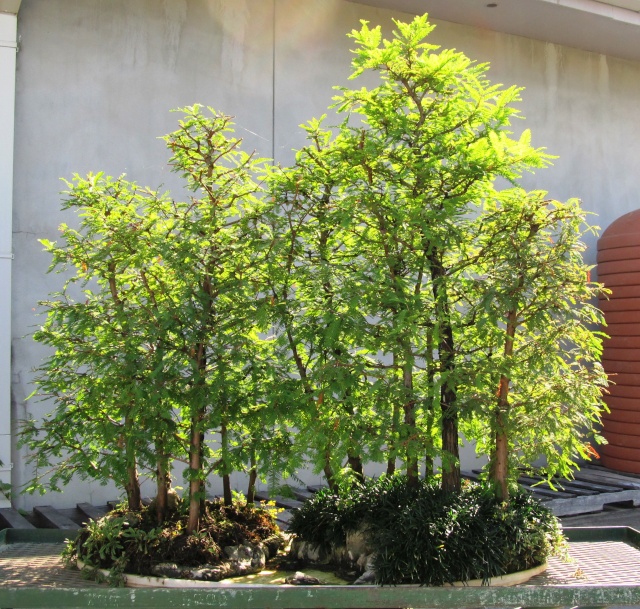
You will notice in the above image that the planting looks rather ragged. I knew at the start of the growing season that the repotting needed to happen this year, but because baldcypress can be repotted in the summer I opted to let this planting sit out of sight in the growing area, more or less neglected. This served no good purpose beyond freeing me to do other things in the meantime.
In the following 2 pictures you can see a problem that arose last year, when the roots of the trees were so packed into the available space that they used their hydraulic force to lift up the rocks that formed the boundary of the suggested stream running through the middle of the landscape. These rocks, brought from China, had been cemented to the marble slab by Mr. Zhao in his demonstration. They had once before been dislodged by baldcypress roots looking for more room to grow, and I had repaired them. Now they were being lifted again and this had to be addressed:


I should mention here that I was assisted in this project by my friend and sometime volunteer assistant, Charlie "C-dog" Dunnagan. In the next 2 images you see Charlie's hands picking up the 2 soil masses on either side of the suggested stream, and you see how the rocks lifted right off of the marble along with them:
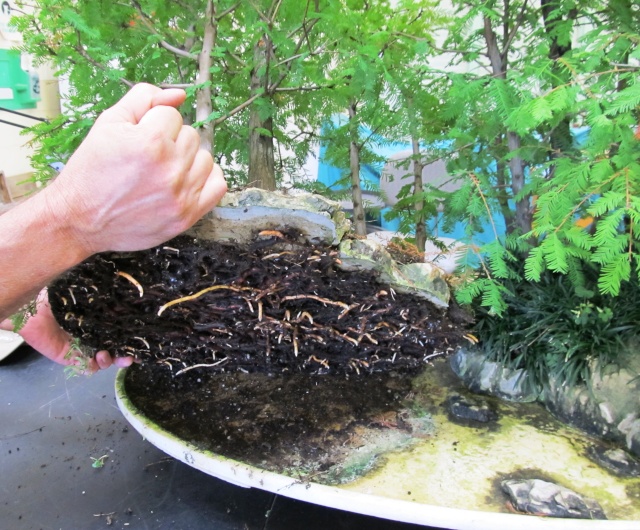
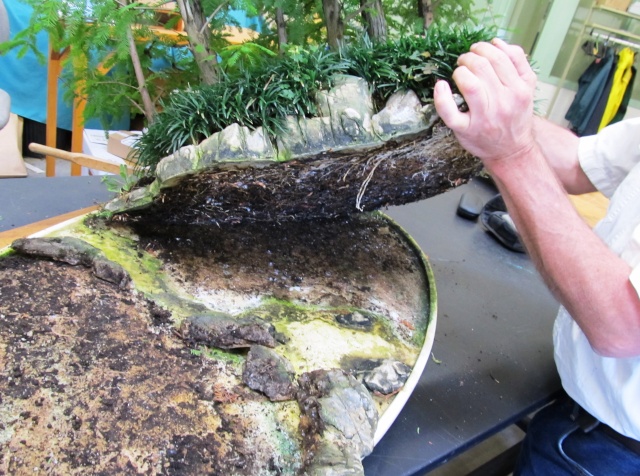
A spray of water was then used to blast away the coarse medium that remained on the marble slab:
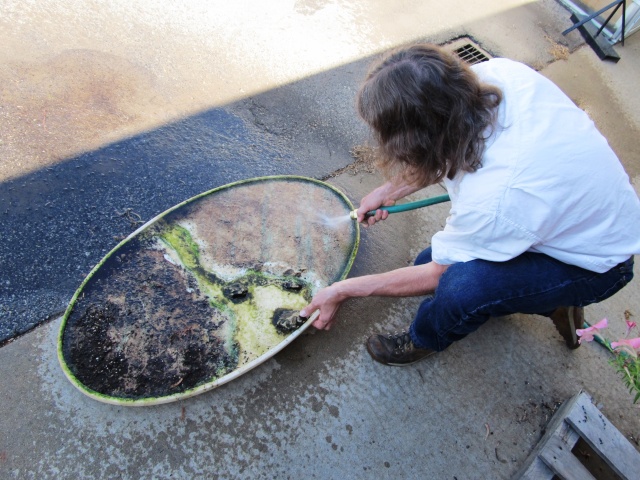
The white marble was heavily stained by the medium and algae, so we took to scrubbing it with a scraper and a variety of stiff brushes:
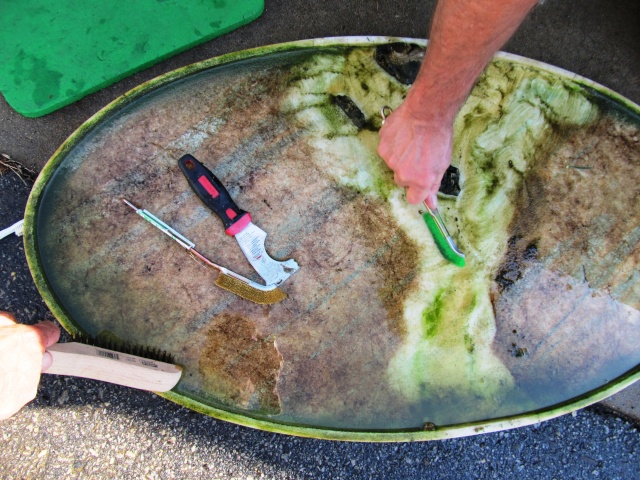
It did not come clean enough, so then we used baking soda:
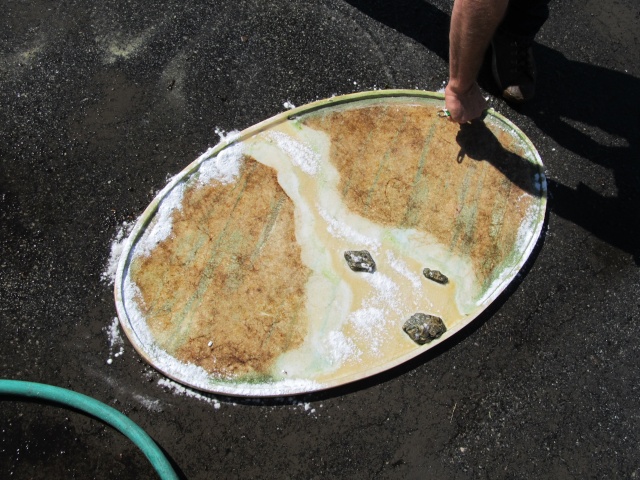
A good deal of staining remained, however. Interesting to note in this next picture that the cleanest part of the slab was that which was covered by the stones that were attached to it:

I was resigned to the fact that the marble was not going to be cleaned to the point of being "good as new". But the algae stains along the rim of the slab still bothered me so I decided to try vinegar, which is a fairly strong acid. C-dog, who was either a professional geologist or an alchemist in his working life (I can never remember which), offered that if I wanted something caustic he could go home and get me "some of the good stuff", but he could not guarantee that it would not dissolve the marble as well. I went with the vinegar:
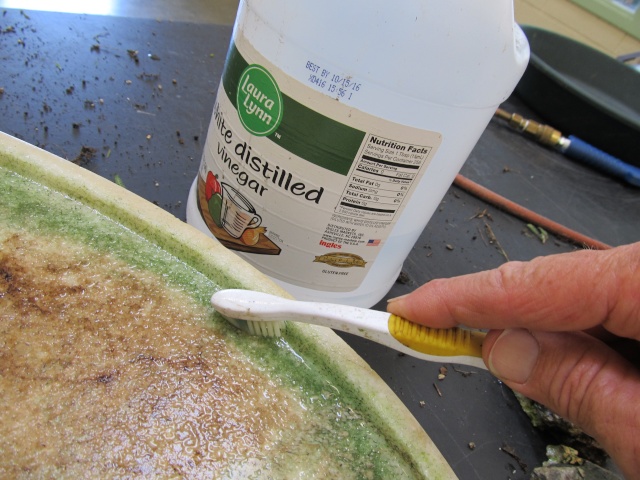
The vinegar did some good, but a bit of the algae remained nonetheless. Looking at the above photograph, I now notice that the vinegar label proudly proclaims that the product is "gluten free", which should be taken as a testimony to the boundless creativity and inherent deceptiveness of marketing people.
We were now ready to reapply the stones to the marble. I had gone to the hardware store and read all the labels of the various products I thought might do the job, and wound up choosing this one:
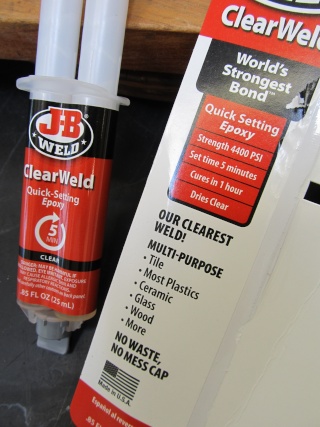
This should not be read as a product endorsement because only time will tell if this epoxy will hold up to the pressure when the roots return. However, I chose it because of the advertised set and curing times, and the amount of p.s.i. pressure it claims to be able to withstand.
The rocks were reset, taking care to place them just as Mr. Zhao originally did:
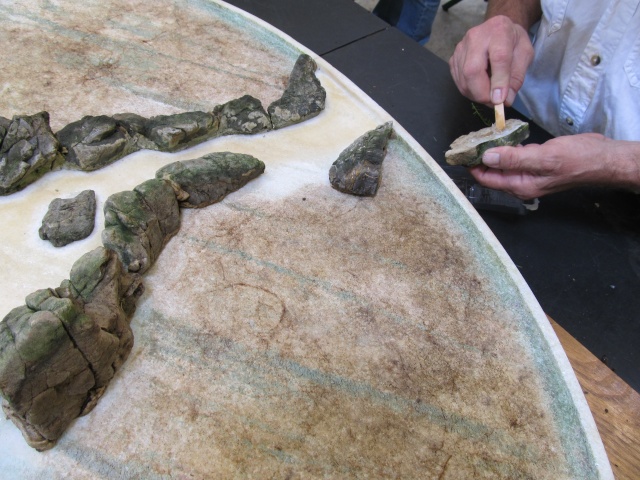

As the epoxied stones were allowed to set and cure, Charlie and I turned our attention to addressing the roots:
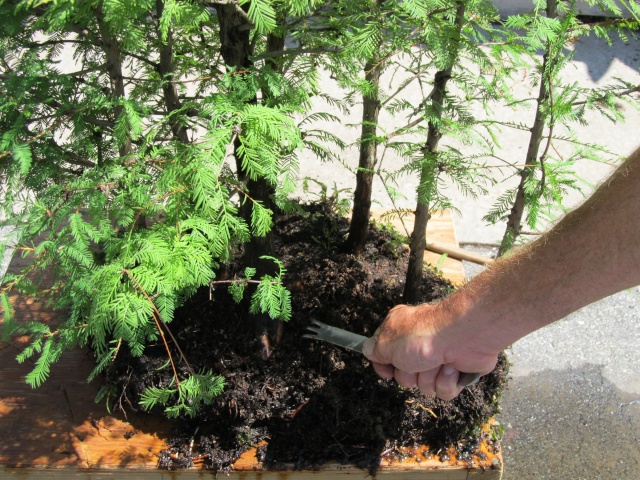
First we raked them out and then we sprayed them with a strong stream of water:
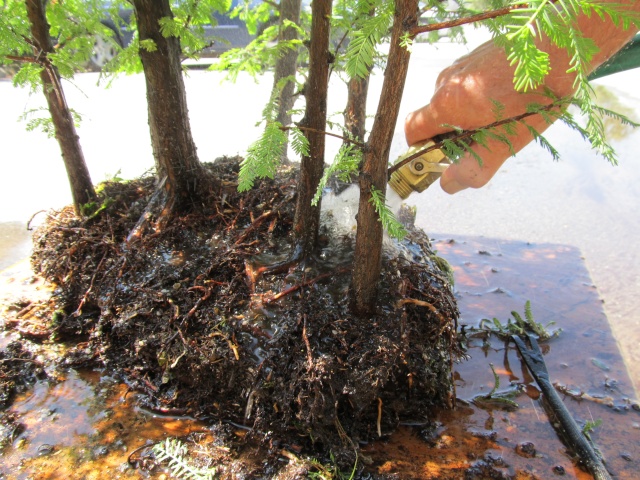
Then the roots that had piled themselves on the top of the soil surface were trimmed:
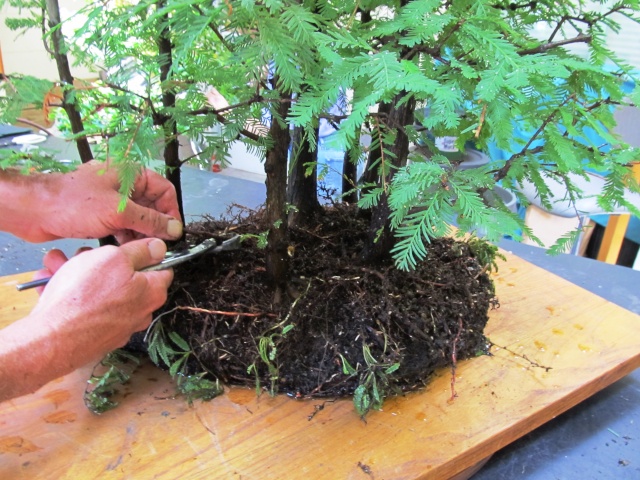
A shot showing how packed the roots were on the bottom:

Time for the weapon of mass destruction:

A trophy piece for the wall of the work area:
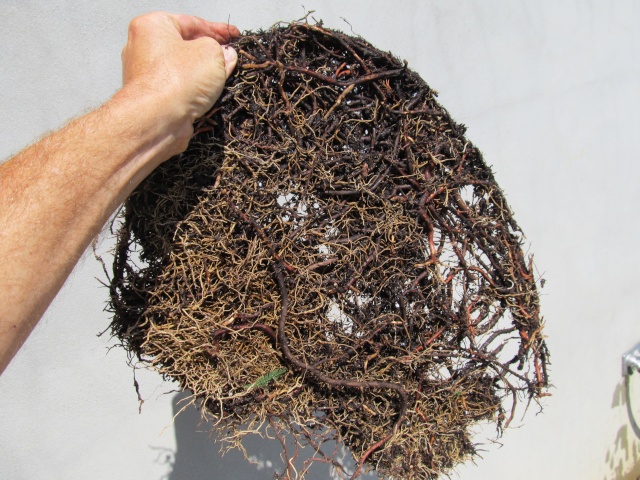
The planting naturally divided into 2 sections, one to either side of the suggested stream running between them, so we addressed first one and then the other. The 2nd one had a dense underplanting of Mondo Grass (Ophiopogon japonicus). There were only a few plugs of it used back when the landscape was originally planted, but they had done well for themselves and multiplied into a monster mondo-mat. We had to tear into it with great force:

Here, with their tops cut off, you can see exactly how dense the mondo grass had become:
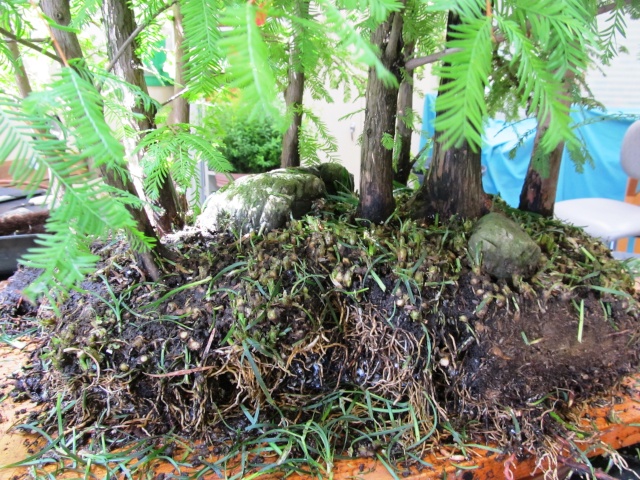
It took a long time to weed out by the roots as much of the mondo grass as we could, and I cannot be certain we got rid of it all. I decided to not plant any of it back, although I would not be surprised if it returned, like a plant version of the Terminator.
Finally the 2 sections of root mass were trimmed and ready for reassembly:

At this point, about 4 hours after we had begun, C-dog left me to finish on my own, muttering on his way out something about having a life. So I thanked him for his time and good help and went about the business of putting the landscape back together. First, a bed of fresh medium for the root masses to sit upon:

The 2 sections back in place:
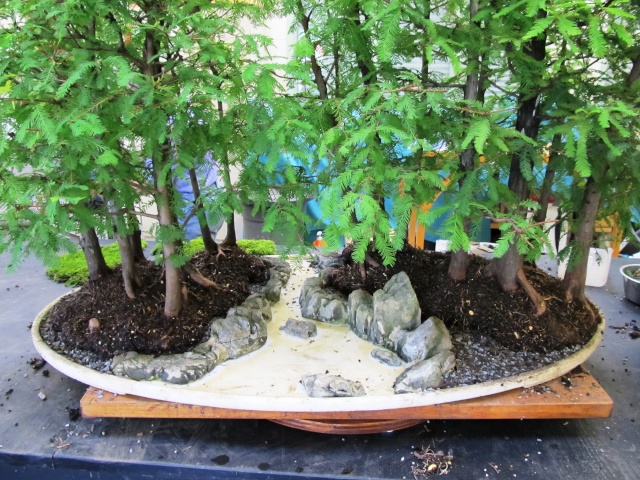
Packing muck around the periphery of the root masses:

Then another volunteer, my longtime, faithful assistant Virginia Turner, went to work applying moss to hold the muck in place:

Finally, after about 13 person-hours of work, the completed project:

For the sake of easy comparison, here in succession are images of this baldcypress tray landscape from 2006, before the repotting, and after:



That's all, folks!
It seems to me I am too much in the habit of complaining on this forum about having too little time and to much to do with it. I cannot think of a good reason to quit doing so now, what with the 19th Carolina Bonsai Expo looming less than 6 weeks away and the 4th US National Bonsai Exhibition taking place this weekend (I will be heading to Rochester, NY in a couple of days and taking an NC Arboretum display with me.) I have been neglectful of this thread for several months and feel badly about that, but I do what I can as I can.
I did a significant repotting project recently and documented it with many photographs. I am going to post them here and provide at least some description of what they show, but those of you who may have developed a taste for my verbosity will be disappointed. I need to limit the time I take doing this, so you will be getting the abridged version of it.
First of all, recognition to Mr. Brook Zhao, the great Chinese penjing artist who created the tray landscape Baldcypress (Taxodium distichum) forest that was the subject of the repotting. Here he is just after the completion of his demonstration in 1998, standing before the newly completed work:

Here is Mr. Zhao picking out the trees for his landscape, choosing among the many young baldcypress plants that can be seen on the ground behind him:

Here is an early photograph of the baldcypress landscape, taken in 2006:

The same, in November of 2012:

Here is an image made this year, just prior to the repotting work:

You will notice in the above image that the planting looks rather ragged. I knew at the start of the growing season that the repotting needed to happen this year, but because baldcypress can be repotted in the summer I opted to let this planting sit out of sight in the growing area, more or less neglected. This served no good purpose beyond freeing me to do other things in the meantime.
In the following 2 pictures you can see a problem that arose last year, when the roots of the trees were so packed into the available space that they used their hydraulic force to lift up the rocks that formed the boundary of the suggested stream running through the middle of the landscape. These rocks, brought from China, had been cemented to the marble slab by Mr. Zhao in his demonstration. They had once before been dislodged by baldcypress roots looking for more room to grow, and I had repaired them. Now they were being lifted again and this had to be addressed:


I should mention here that I was assisted in this project by my friend and sometime volunteer assistant, Charlie "C-dog" Dunnagan. In the next 2 images you see Charlie's hands picking up the 2 soil masses on either side of the suggested stream, and you see how the rocks lifted right off of the marble along with them:


A spray of water was then used to blast away the coarse medium that remained on the marble slab:

The white marble was heavily stained by the medium and algae, so we took to scrubbing it with a scraper and a variety of stiff brushes:

It did not come clean enough, so then we used baking soda:

A good deal of staining remained, however. Interesting to note in this next picture that the cleanest part of the slab was that which was covered by the stones that were attached to it:

I was resigned to the fact that the marble was not going to be cleaned to the point of being "good as new". But the algae stains along the rim of the slab still bothered me so I decided to try vinegar, which is a fairly strong acid. C-dog, who was either a professional geologist or an alchemist in his working life (I can never remember which), offered that if I wanted something caustic he could go home and get me "some of the good stuff", but he could not guarantee that it would not dissolve the marble as well. I went with the vinegar:

The vinegar did some good, but a bit of the algae remained nonetheless. Looking at the above photograph, I now notice that the vinegar label proudly proclaims that the product is "gluten free", which should be taken as a testimony to the boundless creativity and inherent deceptiveness of marketing people.
We were now ready to reapply the stones to the marble. I had gone to the hardware store and read all the labels of the various products I thought might do the job, and wound up choosing this one:

This should not be read as a product endorsement because only time will tell if this epoxy will hold up to the pressure when the roots return. However, I chose it because of the advertised set and curing times, and the amount of p.s.i. pressure it claims to be able to withstand.
The rocks were reset, taking care to place them just as Mr. Zhao originally did:


As the epoxied stones were allowed to set and cure, Charlie and I turned our attention to addressing the roots:

First we raked them out and then we sprayed them with a strong stream of water:

Then the roots that had piled themselves on the top of the soil surface were trimmed:

A shot showing how packed the roots were on the bottom:

Time for the weapon of mass destruction:

A trophy piece for the wall of the work area:

The planting naturally divided into 2 sections, one to either side of the suggested stream running between them, so we addressed first one and then the other. The 2nd one had a dense underplanting of Mondo Grass (Ophiopogon japonicus). There were only a few plugs of it used back when the landscape was originally planted, but they had done well for themselves and multiplied into a monster mondo-mat. We had to tear into it with great force:

Here, with their tops cut off, you can see exactly how dense the mondo grass had become:

It took a long time to weed out by the roots as much of the mondo grass as we could, and I cannot be certain we got rid of it all. I decided to not plant any of it back, although I would not be surprised if it returned, like a plant version of the Terminator.
Finally the 2 sections of root mass were trimmed and ready for reassembly:

At this point, about 4 hours after we had begun, C-dog left me to finish on my own, muttering on his way out something about having a life. So I thanked him for his time and good help and went about the business of putting the landscape back together. First, a bed of fresh medium for the root masses to sit upon:

The 2 sections back in place:

Packing muck around the periphery of the root masses:

Then another volunteer, my longtime, faithful assistant Virginia Turner, went to work applying moss to hold the muck in place:

Finally, after about 13 person-hours of work, the completed project:

For the sake of easy comparison, here in succession are images of this baldcypress tray landscape from 2006, before the repotting, and after:



That's all, folks!
Last edited by Arthur Joura on Wed Sep 10, 2014 4:02 pm; edited 1 time in total

Arthur Joura- Member
Page 11 of 40 •  1 ... 7 ... 10, 11, 12 ... 25 ... 40
1 ... 7 ... 10, 11, 12 ... 25 ... 40 
 Similar topics
Similar topics» American Bonsai at the NC Arboretum
» WISTERIA BONSAI AT INTERNATIONAL BONSAI ARBORETUM
» Ashville arboretum bonsai
» Show the Autumncolour from your bonsai
» Trip to the Rochester Arboretum
» WISTERIA BONSAI AT INTERNATIONAL BONSAI ARBORETUM
» Ashville arboretum bonsai
» Show the Autumncolour from your bonsai
» Trip to the Rochester Arboretum
Page 11 of 40
Permissions in this forum:
You cannot reply to topics in this forum







